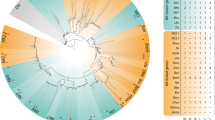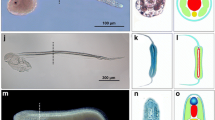Abstract
In recent years, evo–devo studies on non-bilaterian metazoans have improved our understanding of the early evolution of animal body plans. In particular, works on cnidarians suggested that contrary to classical views, the mesoderm originated far before the emergence of the Bilateria. In this context, a synthesis of genomic and functional data concerning the Antennapedia (Antp) superclass of homeobox genes suggested that early in animal evolution, each of the three germ layers was under the control of one cluster of Antp genes. In particular, the patterning and differentiation of the mesoderm was under the control of the NKL cluster. The ctenophores stand as a key taxon with respect to such issues because unlike other non-bilaterian phyla, their intermediate germ layer satisfies the strict embryological definition of a mesoderm. For that reason, we investigated the only known member of the NKL group in Ctenophora, a gene previously isolated from Pleurobrachia and attributed to the Tlx family. In our analysis of the NKL group, this ctenophore gene branches as the sister-group of bilaterian Tlx genes, but without statistical support. The expression pattern of this gene was revealed by in situ hybridisation in the adult ctenophore. The expression territories of PpiTlx are predominantly ectodermal, in two distinct types of ciliated epidermal cells and in one category of gland cells. We also identified a probable endodermal site of expression. Because we failed to detect any mesodermal expression, the results do not provide support to the hypothesis of an ancient functional association between the NKL group and the mesoderm.



Similar content being viewed by others
References
Bae YK, Shimizu T, Muraoka O, Yabe T, Hirata T, Nojima H, Hirano T, Hibi M (2004) Expression of sax1/nkx1.2 and sax2/nkx1.1 in zebrafish. Gene Expr Patterns 4:481–486
Boero F, Gravili C, Pagliara P, Piraino S, Bouillon J, Schmid V (1998) The cnidarian premises of metazoan evolution: from triploblasty, to coelom formation, to metamery. Ital J Zool 65:5–9
Brusca RC, Brusca GJ (2003) Invertebrates, 2nd edn. Sinauer, Sunderland, Massachusetts
Carroll SB, Grenier JK, Weatherbee SD (2005) From DNA to diversity: molecular genetics and the evolution of animal design, 2nd edn. Blackwell, Malden, Massachusetts
Cheng L, Arata A, Mizuguchi R, Qian Y, Karunaratne A, Gray PA, Arata S, Shirasawa S, Bouchard M, Luo P, Chen C-L, Busslinger M, Goulding M, Onimaru H, Ma Q (2004) Tlx3 and Tlx1 are post-mitotic selector genes determining glutamatergic over GABAergic cell fates. Nat Neurosci 7:510–517
Coutinho CC, Fonseca RN, Mansure JJC, Borojevic R (2003) Early steps in the evolution of multicellularity: deep structural and functional homologies among homeobox genes in sponges and higher metazoans. Mech Dev 120:429–440
Darling JA, Reitzel AR, Burton PM, Mazza ME, Ryan JF, Sullivan JC, Finnerty JR (2005) Rising starlet: the starlet sea anemone, Nematostella vectensis. BioEssays 27:211–221
De Graeve F, Jagla T, Daponte J-P, Rickert C, Dastugue B, Urban J, Jagla K (2004) The ladybird homeobox genes are essential for the specification of a subpopulation of neural cells. Dev Biol 270:122–134
Finnerty JR, Master VA, Irvine S, Kourakis MJ, Warriner S, Martindale M (1996) Homeobox genes in the Ctenophora: identification of paired-type and Hox homologues in the atentaculate ctenophore, Beroë ovata. Mol Mar Biol Biotechnol 5:249–258
Finnerty JR, Pang K, Burton P, Paulson D, Martindale MQ (2004) Origins of bilateral symmetry: Hox and Dpp expression in a sea anemone. Science 304:1335–1337
Frohman MA, Dush MK, Martin GR (1988) Rapid production of full-length cDNAs from rare transcripts: amplification using single gene-specific oligonucleotide primer. Proc Natl Acad Sci USA 85:8998–9002
Galliot B, Gauchat D, Miljkovic-Licina M (2004) Neuronal evolution: analysis of regulatory genes in a first-evolved nervous system, the hydra nervous system. BioSystems 76:75–87
Garcia-Fernandez J (2005) The genesis and evolution of homeobox gene clusters. Nat Rev Genet 6:881–892
Glenner H, Hansen AJ, Sorensen MV, Ronquist F, Huelsenbeck JP, Willerslev E (2004) Bayesian inference of the metazoan phylogeny: a combined molecular and morphological approach. Curr Biol 14:1644–1649
Guindon S, Gascuel O (2003) A simple, fast, and accurate algorithm to estimate large phylogenies by Maximum Likelihood. Syst Biol 52:696–704
Hadrys T, DeSalle R, Sagasser S, Fischer N, Schierwater B (2005) The Trichoplax PaxB gene: a putative proto-PaxA/B/C gene predating the origin of nerve and sensory cells. Mol Biol Evol 22:1569–1578
Hayward DC, Samuel G, Pontynen PC, Catmull J, Saint R, Miller DJ, Ball EE (2002) Localized expression of a dpp/BMP2/4 ortholog in a coral embryo. Proc Natl Acad Sci USA 99:8106–8111
Hernandez-Nicaise M-L (1974) Système nerveux et intégration chez les cténaires. Thèses Univ. Claude Bernard, Lyon
Hernandez-Nicaise M-L (1984) Ctenophora. In: Bereiter-Hahn J, Matoltsy AG, Richards KS (eds) Biology of the integument, vol 1: invertebrates. Springer, Berlin Heidelberg New York, pp 96–111
Hernandez-Nicaise M-L (1991) Ctenophora. In: Harrison FW, Westfall JA (eds) Microscopic anatomy of invertebrates, vol 2: Placozoa, Porifera, Cnidaria and Ctenophora. Wiley-Liss, New York, pp 359–418
Horridge GA (1965) Relations between nerves and cilia in ctenophores. Am Zool 5:357–375
Jager M, Hassanin A, Manuel M, Le Guyader H, Deutsch J (2003) MADS-Box genes in Ginkgo biloba and the evolution of the AGAMOUS Family. Mol Biol Evol 20:842–854
Jager M, Quéinnec E, Houliston E, Manuel M (2006) Expansion of the SOX gene family predated the emergence of the Bilateria. Mol Phylogenet Evol 39:468–477
Jagla K, Bellard M, Frasch M (2001) A cluster of Drosophila homeobox genes involoved in mesoderm differentitation programs. BioEssays 23:125–133
Jakob W, Sagasser S, Dellaporta S, Holland P, Kuhn K, Schierwater B (2004) The Trox-2 Hox/ParaHox gene of Trichoplax (Placozoa) marks an epithelial boundary. Dev Genes Evol 214:170–175
Jenner RA (2006) Unburdening evo–devo: ancestral attractions, model organisms, and basal baloney. Dev Genes Evol 216:385–394
Jones DT, Taylor WR, Thornton JM (1992) The rapid generation of mutation data matrices from protein sequences. Comput Appl Biosci 8:275–282
Kamm K, Schierwater B (2006) Ancient complexity of the non-Hox ANTP gene complement in the anthozoan Nematostella vectensis: implications for the evolution of the ANTP superclass. J Exp Zooloq B Mol Dev Evol 306(6):589–596
Kortschak RD, Samuel G, Saint R, Miller DJ (2003) EST analysis of the cnidarian Acropora millepora reveals extensive gene loss and rapid sequence divergence in the model invertebrates. Curr Biol 13:2190–2195
Langenau DM, Palomero T, Kanki JP, Ferrando AA, Zhou Y, Zon LI, Look AT (2002) Molecular cloning and developmental expression of Tlx (Hox11) genes in zebrafish (Danio rerio). Mech Dev 117:243–248
Larroux C, Fahey B, Liubicich D, Hinman VF, Gauthier M, Gongora M, Green K, Wörheide G, Leys SP, Degnan B (2006) Developmental expression of transcription factor genes in a demosponge: insights into the origin of metazoan multicellularity. Evol Dev 8:150–173
Logan C, Wingate RJT, McKay IJ, Lumsden A (1998) Tlx-1 and Tlx-3 homeobox gene expression in cranial sensory ganglia and hindbrain of the chick embryo: markers of patterned connectivity. J Neurosci 18:5389–5402
Manuel M, Le Parco Y (2000) Homeobox gene diversification in the calcareous sponge Sycon raphanus. Mol Phylogenet Evol 17:97–107
Manuel M, Borchiellini C, Alivon E, Le Parco Y, Vacelet J, Boury-Esnault N (2003) Phylogeny and evolution of calcareous sponges: monophyly of Calcinea and Calcaronea, high level of morphological homoplasy, and the primitive nature of axial symmetry. Syst Biol 52:311–333
Martindale MQ (2005) The evolution of metazoan axial properties. Nat Rev Genet 6:917–927
Martindale MQ, Henry J (1997) Ctenophorans, the comb jellies. In: Gilbert SF, Raunio AM (eds) Embryology: constructing the organism. Sinauer, Sunderland, Massachusetts, pp 87–111
Martindale MQ, Henry JQ (1999) Intracellular fate mapping in a basal metazoan, the ctenophore Mnemiopsis leidyi, reveals the origins of mesoderm and the existence of indeterminate cell lineages. Dev Biol 214:243–257
Martindale MQ, Pang K, Finnerty J (2004) Investigating the origins of triploblasty: “mesodermal” gene expression in a diploblastic animal, the sea anemone Nematostella vectensis (phylum, Cnidaria; class, Anthozoa). Development 131:2463–2474
Martinelli C, Spring J (2003) Distinct expression patterns of the two T-box homologues Brachyury and Tbx2/3 in the placozoan Trichoplax adhaerens. Dev Genes Evol 213:492–499
Martinelli C, Spring J (2005) T-box and homeobox genes from the ctenophore Pleurobrachia pileus: comparison of Brachyury, Tbx2/3 and Tlx in basal metazoans and bilaterians. FEBS Lett 579:5024–5028
McMahon AP (2000) Neural patterning: the role of Nkx genes in the ventral spinal cord. Genes Dev 14:2261–2264
Miller DJ, Ball EE, Technau U (2005) Cnidarians and ancestral genetic complexity in the animal kingdom. Trends Genet 21:536–539
Monteiro AS, Schierwater B, Dellaporta SL, Holland PWH (2006) A low diversity of ANTP class homeobox genes in Placozoa. Evol Dev 8:174–182
Nielsen C (1995) Animal evolution: interrelationships of the living phyla. Oxford University Press, Oxford
Nikko E, Van de Vyver G, Richelle-Maurer E (2001) Retinoic acid down-regulates the expression of EmH-3 homeobox-containing gene in the freshwater sponge Ephydatia muelleri. Mech Ageing Dev 122:779–794
Ramos C, Robert B (2005) msh/Msx gene family in neural development. Trends Genet 21:624–632
Richardson MK, Minelli A, Coates MI (1999) Some problems with typological thinking in evolution and development. Evol Dev 1:5–7
Richelle-Maurer E, Boury-Esnault N, Itskovich VB, Manuel M, Pomponi SA, Van de Vyver G, Borchiellini C (2006) Conservation and phylogeny of a novel family of non-Hox genes of the Antp class in Demospongiae (Porifera). J Mol Evol 63:222–230
Ryan JF, Burton PM, Mazza ME, Kwong GK, Mullikin JC, Finnerty JR (2006) The cnidarian–bilaterian ancestor possessed at least 56 homeoboxes. Evidence from the starlet sea anemone, Nematostella vectensis. Genome Biol 7:R54
Seipel K, Schmid V (2005) Evolution of striated muscle: jellyfish and the origin of triploblasty. Dev Biol 282:14–26
Seipel K, Schmid V (2006) Mesodermal anatomies in cnidarian polyps and medusae. Int J Dev Biol 50:589–599
Spring J, Yanze N, Middel AM, Stierwald M, Groger H, Schmid V (2000) The mesoderm specification factor twist in the life cycle of jellyfish. Dev Biol 228:363–375
Spring J, Yanze N, Jösch C, Middel AM, Winninger B, Schmid V (2002) Conservation of Brachyury, Mef2 and Snail in the myogenic lineage of jellyfish: a connection to the mesoderm of Bilateria. Dev Biol 244:372–384
Tamm SL (1982) Ctenophora. In: Shelton GAB (ed) Electrical conduction and behaviour in “simple” invertebrates. Clarendon, Oxford, pp 266–358
Tang SJ, Hoodless PA, Lu Z, Breitman ML, McInnes RR, Wrana JL, Buchwald M (1998) The Tlx-2 homeobox gene is a downstream target of BMP signalling and is required for mouse mesoderm development. Development 125:1877–1887
Technau U, Rudd S, Maxwell P, Gordon PM, Saina M, Grasso LC, Hayward DC, Sensen CW, Saint R, Hostein TW, Ball EE, Miller DJ (2005) Maintenance of ancestral complexity and non-metazoan genes in two basal cnidarians. Trends Genet 21:633–639
Wallberg A, Thollesson M, Farris JS, Jondelius U (2004) The phylogenetic position of the comb jellies (Ctenophora) and the importance of taxonomic sampling. Cladistics 20:558–578
Wang W, Lufkin T (2005) Hmx homeobox gene function in inner ear and nervous system cell-type specification and development. Exp Cell Res 306:373–379
Wilkins AS (2000) Hydra: an out-group moves toward the center. BioEssays 22:200–201
Yamada A, Martindale MQ (2002) Expression of the ctenophore Brain Factor 1 forkhead gene ortholog (ctenoBF-1) mRNA is restricted to the presumptive mouth and feeding apparatus: implications for axial organization in the Metazoa. Dev Genes Evol 212:338–348
Acknowledgements
Specimen collection and manipulations were done at the Station Zoologique in Villefranche-sur-Mer. We thank Evelyn Houliston for providing lab facilities and much help and insights. We are grateful to Muriel Jager, Sandra Chevalier, Pierrette Lamarre and the sailors of the Villefranche zoological station for technical help. We thank Eric Quéinnec and Muriel Jager for advice and discussion. This work was supported by a grant from the French Ministry of Research (ACI jeunes chercheurs) and a grant from the GIS “Institut de la Génomique Marine”-ANR blanche NT_NV_52.
Author information
Authors and Affiliations
Corresponding author
Additional information
Communicated by M.Q. Martindale
Electronic supplementary material
Below is the link to the electronic supplementary material
ESM 1
(DOC 13 kb)
Supplementary Fig. S1
(JPG 166 kb)
Rights and permissions
About this article
Cite this article
Derelle, R., Manuel, M. Ancient connection between NKL genes and the mesoderm? Insights from Tlx expression in a ctenophore. Dev Genes Evol 217, 253–261 (2007). https://doi.org/10.1007/s00427-007-0131-x
Received:
Accepted:
Published:
Issue Date:
DOI: https://doi.org/10.1007/s00427-007-0131-x




